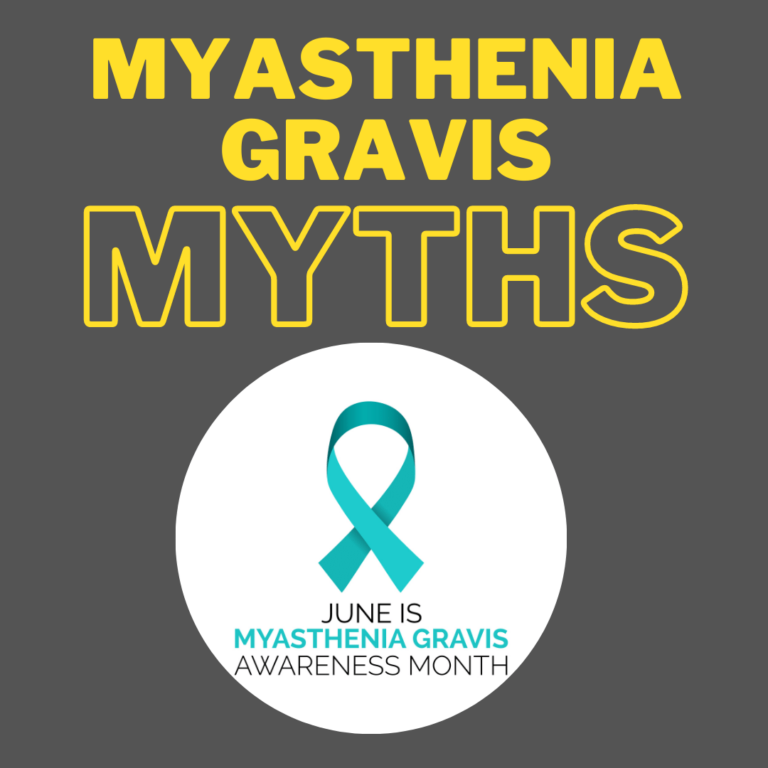In honor of Myasthenia Gravis Awareness Month, we are going to dispel some myths about the condition. Myasthenia Gravis is a chronic autoimmune neuromuscular disease that leads to muscle weakness. It can affect any muscle in the body, including the eyes and respiratory muscles. While there is no cure for MG, it can be managed with medication and lifestyle changes. Let’s take a look at some of the most common myths about MG and set the record straight!

Myth #1: More Exercise will Help
The muscle weakness caused by MG is the result of poor communication between the nerves and muscles. This means that exercise will not always improve muscle strength since the problem is not inactivity. While it is true that exercise can help to improve overall health, in the case of MG, too much exercise can actually make the symptoms worse. People with MG need to be careful not to overdo it and should speak with their doctor before starting any new exercise routine.
Myth #2: The Condition is Terminal
Many people worry that a diagnosis of MG means their lifespan is shortened. However, MG is not a terminal illness. With proper treatment, most people with MG can expect to live a normal lifespan. While there is no cure for MG, it is possible to manage the symptoms and many people live long, healthy lives with the condition. With that being said, in rare cases, it is possible to suffer long-term health issues or a myasthenic crisis, both of which can be life-threatening.
Myth #3: It is an STI
There is a sexually-transmitted infection called mycoplasma genitalium that often gets abbreviated to “MG”. In some cases, this can cause confusion when the abbreviation MG is used to describe myasthenia gravis. Despite the fact that both conditions share an abbreviation, there is no relationship between the two.
Myasthenia Gravis (MG) is not an STI. It is an autoimmune disease, which means that the body’s immune system attacks healthy tissue. It is not caused by any virus or bacteria and cannot be passed from one person to another.
Myth #4: It Causes Blindness
MG does not cause blindness. In some cases, however, the muscles that control the eyelids can be affected, leading to drooping eyelids or double vision. The use of medications and/or resting the eyelids can help decrease these symptoms. Oftentimes, drooping eyelids and/or double vision are some of the first symptoms of MG.
Myth #5: There is a Miracle Pill
Unfortunately, there is no miracle pill for MG since this condition affects everyone differently. While there are treatments that can help to manage the symptoms of MG, there is no cure for the condition. In many cases, it takes a combination of the right medications, proper diet, and certain lifestyle changes to minimize symptoms and side effects. With these treatments, many people with MG are able to live normal, healthy lives.

Myth #6: People with MG are Just Lazy
MG can be unpredictable and fatigue can strike at any time without warning. Because of this, a person with MG can be fine at one moment and then unable to complete a basic task the next moment. Then, they may recover and be fine once again. Unfortunately, this makes some people think that individuals with MG are simply lazy or uncooperative. MG is not laziness. It is a chronic, autoimmune disease that causes muscle weakness. People with MG cannot help their symptoms and should not be made to feel like they are lazy or doing something wrong.
Myth #7: People with MG Cannot Work
Due to the unpredictability of MG, people often worry that this means they will be unable to work. However, MG does not have to be a barrier to employment. While the symptoms of MG can make it difficult to work, many people with the condition are able to lead normal, productive lives. There are also accommodations that can be made in the workplace to help people with MG succeed. With that being said, severe cases of MG or cases that have not established an effective treatment regime, may make working temporarily impossible.
Myth #8: They Look Normal
MG is an invisible illness, meaning that symptoms are not always visibly evident to others. Just because someone looks “normal” does not mean they are not suffering from a debilitating disease. Symptoms of MG can range from mild to severe and can come on suddenly or gradually. This means that a person with MG may look fine one day but be unable to walk the next. It is important to remember that just because someone looks normal, it does not mean they are not struggling.
Myth #9: Mind Over Matter
MG is not a psychological condition. It is a physical, autoimmune disease that affects the nerves and muscles. While stress and anxiety can make symptoms worse, they do not cause MG. Mind over matter will not cure MG. The only thing that can help manage the symptoms of MG are treatment options like medication, diet, and lifestyle changes.
In Conclusion
In this blog, we have debunked some of the most common myths about Myasthenia Gravis. We hope that this blog post has helped to dispel some of the myths about Myasthenia Gravis and will help to spread awareness and understanding about this condition. If you or someone you know has MG, please remember that you are not alone. There are many resources and support groups available to help people with MG live normal, healthy lives.

Dr. Kashouty, a diplomate of the American Board of Psychiatry and Neurology (ABPN), practices general neurology with fellowship trained specialization in clinical neurophysiology. Dr. Kashouty finds the form and function of the nerves and muscles the most interesting part of neurology, which is what led him to specialize in neurophysiology with more emphasis on neuromuscular conditions. He treats all neurological diseases, but his main focus is to treat and manage headaches, movement disorders and neuromuscular diseases.




